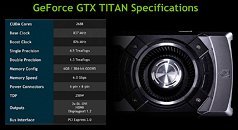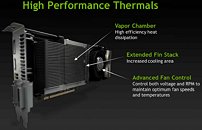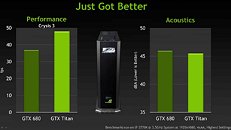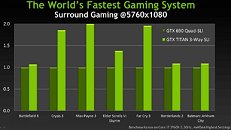Tuesday, February 19th 2013

NVIDIA GeForce GTX Titan Final Specifications, Internal Benchmarks Revealed
Specifications of NVIDIA's upcoming high-end graphics card, the GeForce GTX Titan, which were reported in the press over the last couple of weeks, are bang on target, according to a specs sheet leaked by 3DCenter.org, which is allegedly part of the card's press-deck. According to the specs sheet, the GTX Titan indeed features 2,688 out of the 2,880 CUDA cores present on the GK110 silicon, 6 GB of GDDR5 memory across a 384-bit wide memory interface, and draws power from a combination of 6-pin and 8-pin PCIe power connectors.
The GeForce GTX Titan core is clocked at 837 MHz, with a GPU Boost frequency of 876 MHz, and 6.00 GHz memory, churning out 288 GB/s of memory bandwidth. The chip features a single-precision floating-point performance figure of 4.5 TFLOP/s, and 1.3 TFLOP/s double-precision. Despite its hefty specs that include a 7.1 billion-transistor ASIC and 24 GDDR5 memory chips, NVIDIA rates the card's TDP at just 250W.More slides and benchmark figures follow.
The next slide leaked by the source reveals key features of the reference design cooling solution, which uses a large lateral blower that features RPM and voltage-based speed control on the software side, a vapor-chamber plate that draws heat from the GPU, memory, and VRM; and an extended aluminum fin stack that increases surface area of dissipation.Next up, we have performance numbers by NVIDIA. In the first slide, we see the GTX Titan pitted against the GTX 680, in Crysis 3. The GTX Titan is shown to deliver about 29 percent higher frame-rates, while being a tiny bit quieter than the GTX 680.
In the second slide, we see three GeForce GTX Titans (3-way SLI) pitted against a pair of GeForce GTX 690 dual-GPU cards (quad-SLI). In every test, the Titan trio is shown to be faster than GTX 690 Quad-SLI. In Crysis 3, GTX Titan 3-way SLI is shown to be about 75 percent faster; 100 percent faster in Max Payne 3, 40 percent faster in TESV: Skyrim, and 95 percent faster in Far Cry 3. Why this comparison matters for NVIDIA is that if Titan does end up being a $1000 product, NVIDIA will have to sell three of them while offering something significantly better than GTX 690 quad-SLI.
Source:
3DCenter.org
The GeForce GTX Titan core is clocked at 837 MHz, with a GPU Boost frequency of 876 MHz, and 6.00 GHz memory, churning out 288 GB/s of memory bandwidth. The chip features a single-precision floating-point performance figure of 4.5 TFLOP/s, and 1.3 TFLOP/s double-precision. Despite its hefty specs that include a 7.1 billion-transistor ASIC and 24 GDDR5 memory chips, NVIDIA rates the card's TDP at just 250W.More slides and benchmark figures follow.
The next slide leaked by the source reveals key features of the reference design cooling solution, which uses a large lateral blower that features RPM and voltage-based speed control on the software side, a vapor-chamber plate that draws heat from the GPU, memory, and VRM; and an extended aluminum fin stack that increases surface area of dissipation.Next up, we have performance numbers by NVIDIA. In the first slide, we see the GTX Titan pitted against the GTX 680, in Crysis 3. The GTX Titan is shown to deliver about 29 percent higher frame-rates, while being a tiny bit quieter than the GTX 680.
In the second slide, we see three GeForce GTX Titans (3-way SLI) pitted against a pair of GeForce GTX 690 dual-GPU cards (quad-SLI). In every test, the Titan trio is shown to be faster than GTX 690 Quad-SLI. In Crysis 3, GTX Titan 3-way SLI is shown to be about 75 percent faster; 100 percent faster in Max Payne 3, 40 percent faster in TESV: Skyrim, and 95 percent faster in Far Cry 3. Why this comparison matters for NVIDIA is that if Titan does end up being a $1000 product, NVIDIA will have to sell three of them while offering something significantly better than GTX 690 quad-SLI.




132 Comments on NVIDIA GeForce GTX Titan Final Specifications, Internal Benchmarks Revealed
Quick math says
837 * 2688 shaders * 2 op/clock = 4499.7 TFLOP FP32 / 3 = 1.5 TFLOP FP64
It's like 2 GTX660Ti's in one package :peace:
I'm also going by the available information in the leak.
As for diluting the K20/K6000, that has usually been the case of artificially limiting FP64 performance in gaming cards. Maybe the Titan is a special case- if so, and the user requires FP64 but has no need of ECC memory or pro drivers and 24/7 support, then the Titan makes an attractive alternative to a $3K Tesla K20 or $4.5K K20X
The way they were talking I was expecting a good 50% faster than a 7970 or 680.
It's bloody brilliant :respect:
my 7950 only cost me $200 as well, after I sold the 3 free games it came with :)
>Assuming a release price of $900, it would be ~$1150 here in my country (in Yurip) after including all the taxes an sh*t.
uhm, ghey.